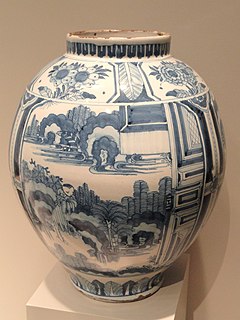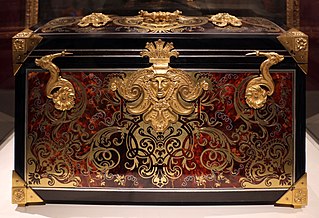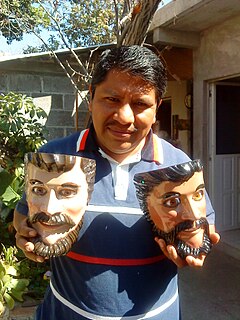Techniques
In the Ascot buffet, armoire and tallboy, Martin Pierce uses gold and silver leaf to create scenes that appear three-dimensional. The technique he uses is one that combines aspects of japanning with gilding. [9] In England in the 17th and 18th century, japanning became very popular and it was used extensively to decorate furniture with raised scenes of birds, flowers and pagodas. At that time, a type of glue called sizing and whitening were applied in successive layers onto a wood surface, which was then blackened or colored before being varnished and polished. Designs were then traced onto the prepared background where they were either decorated by color or with gold. The artisans would add further interest to these scenes by raising the decorated areas. This was accomplished by applying a thick compound of sawdust, whitening and gum Arabic.
Martin Pierce has borrowed much from the technique of japanning and the style of Chinoiserie but he brought them into a modern context, substituting easier mediums for the traditional varnish, size and gum Arabic. Since Martin Pierce creates his designs over a beautiful background of walnut or English brown oak wood, he does not blacken or hide the wood. Martin likes the raised textural nature of japanning, but he substitutes casein, which is a white paste made from milk by-products for its 17th-century cousin. Casein is easily applied either as a thick coat with a hand trowel or, for delicate thin leaf stems, with a fine brush. Casein has the advantage of drying quickly and affords a soft enough surface that can be sanded smooth with 220-grit sandpaper. Martin applies successive coats of casein until the design is sufficiently raised and then seals it with a water-based lacquer.
In traditional gilding, the gilder applies his gold over a surface of firm clay that provides a solid surface that he can burnish and thereby make the gold very bright and brassy. Martin Pierce omits this step, as he feels the gold and silver are sufficiently iridescent and because he prefers a more muted appearance. He also substitutes a modern product called wonder size for the traditional gold size, as he also prefers its cold application making it easier to control. Once the size is dry, he carefully applies the wafer thin gold which he presses down into place and carefully rubs with fine wax paper.
Now the real art work begins as he applies different colored glazes over the gold scene. The glaze is made from a mixture of oil paint diluted with paint thinner, and the glazes vary in consistency depending on how much of the gold Martin wants to expose. Martin also uses water spotting to create a natural age to his leaves and stems, which dulls down their pristine appearance. Each of these pieces is signed, numbered, and dated and forms part of a limited edition available through Martin Pierce, or through a design professional.

Furniture refers to movable objects intended to support various human activities such as seating, eating (tables), and sleeping. Furniture is also used to hold objects at a convenient height for work, or to store things. Furniture can be a product of design and is considered a form of decorative art. In addition to furniture's functional role, it can serve a symbolic or religious purpose. It can be made from many materials, including metal, plastic, and wood. Furniture can be made using a variety of woodworking joints which often reflect the local culture.

Delftware or Delft pottery, also known as Delft Blue, is a general term now used for Dutch tin-glazed earthenware, a form of faience. Most of it is blue and white pottery, and the city of Delft in the Netherlands was the major centre of production, but the term covers wares with other colours, and made elsewhere. It is also used for similar pottery, English delftware.

Marquetry is the art and craft of applying pieces of veneer to a structure to form decorative patterns, designs or pictures. The technique may be applied to case furniture or even seat furniture, to decorative small objects with smooth, veneerable surfaces or to freestanding pictorial panels appreciated in their own right.

Lacquer is a type of hard and potentially shiny coating or finish applied to materials such as wood or metal. The term originates from the Sanskrit word lākshā (लाक्षा), representing the number one hundred thousand (100,000), which was used for both the lac insect and the scarlet resinous secretion, rich in shellac that it produces, used as wood finish in ancient India and neighbouring areas.

Émile Gallé was a French artist and designer who worked in glass, and is considered to be one of the major innovators in the French Art Nouveau movement. He was noted for his designs of Art Nouveau glass art and Art Nouveau furniture, and was a founder of the École de Nancy or Nancy School, a movement of design in the city of Nancy, France.

Gilding is a decorative technique for applying a very thin coating of gold to solid surfaces such as metal, wood, porcelain, or stone. A gilded object is also described as "gilt". Where metal is gilded, the metal below was traditionally silver in the West, to make silver-gilt objects, but gilt-bronze is commonly used in China, and also called ormolu if it is Western. Methods of gilding include hand application and gluing, typically of gold leaf, chemical gilding, and electroplating, the last also called gold plating. Parcel-gilt objects are only gilded over part of their surfaces. This may mean that all of the inside, and none of the outside, of a chalice or similar vessel is gilded, or that patterns or images are made up by using a combination of gilt and ungilted areas.

Decoupage or découpage is the art of decorating an object by gluing colored paper cutouts onto it in combination with special paint effects, gold leaf and other decorative elements. Commonly, an object like a small box or an item of furniture is covered by cutouts from magazines or from purpose-manufactured papers. Each layer is sealed with varnishes until the "stuck on" appearance disappears and the result looks like painting or inlay work. The traditional technique used 30 to 40 layers of varnish which were then sanded to a polished finish.

Japanning is a type of finish that originated as a European imitation of East Asian lacquerwork. It was first used on furniture, but was later much used on small items in metal. The word originated in the 17th century. American work, with the exception of the carriage and early automobile industries, is more often called toleware.

Wood stain is a type of paint used to colour wood.

Kitchen cabinets are the built-in furniture installed in many kitchens for storage of food, cooking equipment, and often silverware and dishes for table service. Appliances such as refrigerators, dishwashers, and ovens are often integrated into kitchen cabinetry. There are many options for cabinets available at present.

Wood finishing refers to the process of refining or protecting a wooden surface, especially in the production of furniture where typically it represents between 5 and 30% of manufacturing costs.

Gold leaf is gold that has been hammered into thin sheets by goldbeating and is often used for gilding. Gold leaf is available in a wide variety of karats and shades. The most commonly used gold is 22-karat yellow gold.

The Rockingham Pottery was a 19th-century manufacturer of porcelain of international repute, supplying fine wares and ornamental pieces to royalty and the aristocracy in Britain and overseas, as well as manufacturing porcelain and earthenware items for ordinary use.

Byōbu (屏風) are Japanese folding screens made from several joined panels, bearing decorative painting and calligraphy, used to separate interiors and enclose private spaces, among other uses.

Distressing in the decorative arts is the activity of making a piece of furniture or object appear aged and older, giving it a "weathered look", and there are many methods to produce an appearance of age and wear. Distressing is viewed as a refinishing technique although it is the opposite of finishing in a traditional sense. In distressing, the object's finish is intentionally destroyed or manipulated to look less than perfect, such as with sandpaper or paint stripper. For example, the artisan often removes some but not all of the paint, leaving proof of several layers of paint speckled over wood grain underneath. This becomes the "finished" piece.

Inlay covers a range of techniques in sculpture and the decorative arts for inserting pieces of contrasting, often coloured materials into depressions in a base object to form ornament or pictures that normally are flush with the matrix. A great range of materials have been used both for the base or matrix and for the inlays inserted into it. Inlay is commonly used in the production of decorative furniture, where pieces of coloured wood, precious metals or even diamonds are inserted into the surface of the carcass using various matrices including clearcoats and varnishes. Lutherie inlays are frequently used as decoration and marking on musical instruments, particularly the smaller strings.

Goryeo ware refers to all types of Korean pottery and porcelain produced during the Goryeo dynasty, from 918 to 1392, but most often refers to celadon (greenware).

A cabinet is a case or cupboard with shelves and/or drawers for storing or displaying items. Some cabinets are stand alone while others are built in to a wall or are attached to it like a medicine cabinet. Cabinets are typically made of wood, coated steel, or synthetic materials. Commercial grade cabinets usually have a melamine-particleboard substrate and are covered in a high pressure decorative laminate, commonly referred to as Wilsonart or Formica.

Tlaxcala handcrafts and folk art is that which comes from the smallest state in Mexico, located in the center-east of the country. Its best-known wares are the "canes of Apizaco", sawdust carpets and the making of Saltillo-style serapes. However, there are other handcraft traditions, such as the making of pottery, including Talavera type wares, cartoneria, metalworking and stone working. The state supports artisans through the activities of the Fideicomiso Fondo de la Casa de las Artesanía de Tlaxcala

Louis XVI furniture is characterized by elegance and neoclassicism, a return to ancient Greek and Roman models. Much of it was designed and made for Queen Marie Antoinette for the new apartments she created in the Palace of Versailles, Palace of Fontainebleau, the Tuileries Palace, and other royal residences. The finest craftsmen of the time, including Jean-Henri Riesener, Georges Jacob, Martin Carlin, and Jean-François Leleu, were engaged to design and make her furniture.



















